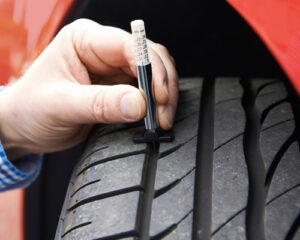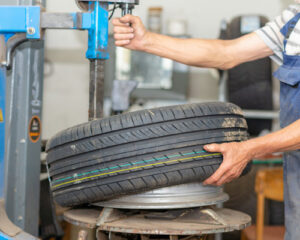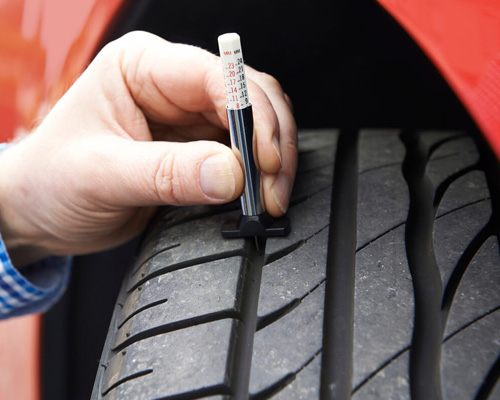Transform your vehicle’s look and functionality with the best Alloy Rims in Pakistan, designed to upgrade your style.
Author: admin
Free Consultation
Tyre consultation is no longer limited to taking the best guess on tyre price.
Tyre Rotator
Forward Cross – The most commonly used rotation pattern, designed primarily for front wheel drive vehicles – which most cars have. Front-to-Rear & Rear-to-Front – Primarily used for performance vehicles equipped with directional tires of the same size. Ideally, tires should be rotated every 3,000 to 5,000 miles. When this is done consistently, the tires are more likely to maintain good handling and traction and deliver maximum tread life. However, it’s important to remember that tire rotation alone cannot guard against rapid or uneven wear if your vehicle has faulty mechanical parts or improper tire inflation pressure.
Rearward Cross – For Rear Wheel And 4-wheel Drive Vehicles.
Rotation Patterns Explained Below:
Side-To-Side – Primarily used for vehicles equipped with non-directional tires of different sizes. Temporary-use spares cannot be included in your tire rotation. What about the spare tire? – If your spare tire is of the same size as the four tires in service, you should include that spare in your rotation pattern. Follow the manufacturer’s recommended rotation sequence, or introduce the spare into the rotation pattern in the right rear position. X-Cross – Also for rear wheel and 4-wheel drive vehicles – but can also be used as an alternative to the Forward Cross method for front wheel drive vehicles.
Performance
High Performance Tire Characteristics
- Typically have aspect ratios of 60
- Have an H speed rating
- Provide improved traction and handling as compared to non-performance tires
- Often provide all-season capabilities – but some are not built for snow and ice
- Are generally less expensive than Ultra High Performance products
Ultra High Performance Tire Characteristics
- Typically have aspect ratios of 55 or lower
- Have speed ratings of V or above
- Typically are designed for rim diameters of 16″ and above
- Provide excellent traction, cornering and overall handling
- Have stiffer sidewalls to maximize contact with the road during cornering
- Not designed for snow and ice – although there are exceptions
Aspect Ratio
- The aspect ratio is the section height of the tire divided by its section width
- Low aspect ratio tires are wider and have shorter, stiffer sidewalls
- Low aspect ratios deliver enhanced performance attributes such as hard cornering and improved handling
- Low aspect ratio tires also impart a sporty, modern look
Example of Sidewall Markings:
- P = passenger
- 215 = section width (mm)
- 45 = aspect ratio (section height/section width)
- R = radial construction
- 17 = rim diameter
Speed Rating
A tire with the proper speed rating is important for a vehicle’s overall performance capability.
When replacing a tire, always match or exceed the speed rating of the vehicle’s original equipment to preserve the performance capabilities of your vehicle.
A speed rating indicates the maximum speed at which a tire can perform based on controlled tests – but it does not sanction operating speeds beyond what’s permissible by law.
A speed rating is identified within an alphanumeric “service description” code.
Example of Service Description (load index + speed rating) 99H
99 = load index, equating to a max load carrying capacity of 1,709 lbs.
H = speed rating, indicating a maximum safe speed of 130 mph
Tyre Rating
There are a number of things to consider when purchasing tires for your vehicle. Specifically, these considerations can be categorized as follows:
- Tread Pattern Design – “All-Season” vs. “Touring” vs. “Performance”
- Tread wear Performance vs. Grip/Handling Traction Performance
- Tire Speed-Rating – S, T, H, V, W, Y, Z
- High Performance Tires
There is a tire line to fit virtually every driver/vehicle combination and need, and there is a significant amount of overlap in different tire lines to satisfy these different combinations of needs. For example, there are …
- All-Season/Grip/S Speed-rated/Low price tires
- Touring/Tread wear/H Speed-rated/High price tires
- All-Season/Tread wear/T Speed-rated/Medium price tires
- Performance/Grip/Z Speed-rated/High price tires
all designed to meet customer needs. Let’s look at each of the considerations listed above in more detail.
ALL-SEASON VS. TOURING VS. PERFORMANCE
All-Season tread designs will provide good all-around traction for varying road conditions such as wet, snow and ice, but still provide good tread wear and tire noise characteristics. Performance tread designs have been engineered to enhance a vehicle’s handling capabilities on wet and dry roads, but usually exhibit increased tire noise and lack long tread wear life. Performance tread designs generally have larger tread elements to provide a stiff tread area for handling performance. Touring tread designs were designed to bridge the gap between all-season and performance tires. Touring tread designs combine the technology for good tread wear characteristics from all-season tires and handling and grip associated with performance tires. Touring tires also exhibit very good tire noise and ride comfort.
TREAD WEAR PERFORMANCE VS. GRIP/HANDLING/TRACTION PERFORMANCE
The tread wear/traction trade-off has been a focus in tire performance-enhancement technology for decades. Tire companies have been trying to reduce the trade-off between tread wear and traction through the development of new rubber compounds, new tread designs and new tire construction techniques. Basically, a tire will wear out quickly if it’s providing maximum grip to the road. This is due to the tread rubber being torn from the tire (on a microscopic level), while it adheres to the road surface. An excellent tread wear tire minimizes the amount of rubber being removed at the road surface, thus providing long tread life, but less road-gripping traction.
TIRE SPEED-RATING (S, T, H, V, W, Y, Z)
A common trade-off for higher speed-rating is reduced ride comfort. An S speed-rated tire will give a more comfortable ride compared to an H speed-rated tire – and an H speed-rated tire will give a more comfortable ride compared to a Z speed-rated tire. The ride comfort characteristics can be attributed to the tire’s overall stiffness. A tire capable of running at high speeds requires a more stiff construction in order to provide the necessary high speed stability and durability.
TIRE SPEED RATINGS
Symbol Max Speed (mph & km/h)
Q 99 mph & 160 km/h
R 106 mph & 170 km/h
S 112 mph & 180 km/h
T 118 mph & 190 km/h
U 124 mph & 200 km/h
H 130 mph & 210 km/h
V 149 mph & 240 km/h
W 168 mph & 270 km/h
Y 186 mph & 300 km/h
ZR Above 300 km/h or 186mph
Z speed-rated tires originally reflected the highest tire speed rating – i.e., in excess of 149 mph. When new cars were developed that could exceed this speed, the automotive industry added the W and Y ratings. While a Z speed-rating still often appears, such as 215/50ZR16 91W, the Z in the size signifies a maximum speed capability in excess of 149 mph; the W in the service description indicates the tire’s 168 mph maximum speed. When the Y speed-rating in a service description is enclosed in parentheses, such as 285/35ZR19 (99Y), the top speed of the tire has been tested in excess of 186 mph, indicated by the service description as shown below:
PRICE
As with the many different levels of tread design, tire performance and speed-ratings, there are many different levels of pricing within a category. For example, prices can vary from $50 per tire to $125 per tire depending on the brand name. When you multiply this price by four wheel positions, the price can become expensive and more difficult to justify.
HIGH PERFORMANCE TIRES
High Performance tires typically have speed-ratings of H or higher, although tire companies have developed entry-level performance tires that exhibit S and T speed-ratings for the people who want only the “look” of performance.
In order to maximize handling from a tire, high performance tire tread widths are wider than a typical all-season and touring tire. This allows maximum contact area with the road surface. In this case, wider is definitely better! The tread pattern incorporates larger tread blocks for increased stiffness. The tread compound is usually softer than a typical all-season and touring tire in order to provide more dry traction capability. Faster tread wear (less tread life) is generally observed in high performance tires because of the better dry traction capability. Racing tires are an extreme example of high performance tires, exhibiting maximum dry traction and grip, with significantly reduced tread wear life.
The stiffer construction used in high performance tires not only aids high-speed performance, but enhances tire handling characteristics. A high performance tire has quick steering response and plenty of available cornering power, which makes for excellent vehicle handling characteristics. Nylon reinforcement creates a stiffer belt package, which means better steering response and higher cornering grip. Usually, the carcass plies are angled or “biased” to increase the tire’s overall stiffness.
Air Pressure
Air pressure for your new tire should be set in accordance with the vehicle manufacturer’s specification if it’s the same as the size originally equipped on your vehicle. The vehicle manufacturer’s recommendation can usually be found in the owner’s manual, on the door jamb or in the glove compartment. Contact the vehicle dealer for more specific information about your car. Vehicle placard inflation would be the minimum recommended inflation by Tire.
The importance of maintaining the proper air pressure cannot be overstated. Under-inflation can lead to excessive heat build-up and structural stress and can cause a tire to fail. Over-inflation can cause uneven tire wear in the center portion of the tread pattern and can also lead to vehicle handling problems. Do not check tire pressure after the vehicle has been operated because tires heat up, causing the air pressure to rise. Allow them to cool and then perform your check.
Check your spare tire as well. The proper air pressure for a spare is often different from the tires mounted on your vehicle. The proper air pressure for your spare should also be listed in your owner’s manual, door jamb or glove compartment. Use a quality air gauge when checking the pressure (digital gauges are the most reliable) or have a professional service technician do the work for you. Maintaining proper air pressure will also contribute to better fuel efficiency. So check, be safe and save more
Tyre Safety
Driving on any under inflated tire is dangerous and may result in sudden tire destruction caused by excessive heat build-up. For replacement tires, your tire retailer should provide you with the proper inflation pressure. Otherwise, follow the air pressure recommendation found within your vehicle’s owner manual or tire placard in your vehicle. If your replacement tire size is different from the original equipment tire size, ask your tire retailer for a revised air pressure recommendation guide in order to adequately support your vehicle’s gross vehicle weight rating. Check the cold inflation pressure in all of your tires, including the spare tire, at least once every week and always prior to long distance trips. Failure to maintain the proper air inflation pressure may result in improper vehicle handling and may cause rapid and irregular tire wear, reduction in tire durability, loss of vehicle control, or sudden tire failure that may lead to property damage, serious personal injury or death.
Use an accurate tire gauge to check tire air pressures. Always maintain the proper recommended air inflation pressure in all tires. If there is an indication that one of your tires has lost four or more pounds of air pressure, immediately look for signs of penetration through the tire, valve leaks or wheel damage that may account for the air loss. You should also have your tires inspected by a tire retailer immediately.
Air Pressure Guide Air pressure should be checked when tires are cold (before they have been driven), ideally in the early morning. Driving, regardless of distance, causes tires to heat up and simultaneously increase air pressure. Never exceed the maximum inflation pressure for the tire. Never bleed air from hot tires as this may result in under-inflation.
Inspect your tires daily. If you notice any damage to your tires or wheels, replace them with a spare and immediately visit any tire retailer for advice. Driving over potholes, curbs, wood debris, metal, etc., can damage a tire and should be safely avoided. Contact with such hazards requires an immediate and thorough tire inspection by your tire retailer.
Always examine your tires for penetrations, bulges, cracks, cuts and abnormal wear – particularly at the tire edges – which may be caused by, for example, vehicle misalignment or tire under-inflation. Failure to properly control a vehicle when one or more tires are under-inflated may result in an accident. Use of a damaged tire may result in rapid air loss, including sudden tire failure.
An explosion of the tire/rim assembly may occur because of improper mounting. Only specially trained persons should mount tires. Failure to store tires in accordance with the following recommendations may result in damage to your tires, reduction in tire durability, or sudden tire failure.
Tires should always be stored in a cool, dry, clean, indoor environment. Tires contain waxes and emollients to protect their outer surfaces from ozone and weather cracking. As the tire rolls and flexes, the waxes and emollients continually migrate to the tire’s surface, replenishing this protection throughout the normal and proper use of the tire. However, when tires sit outdoors and are unused for an extended period of time, the tire surface become dry, the tire may be susceptible to ozone and weather cracking, and the casing becomes susceptible to flat spotting. Surfaces on which tires are stored must be free from grease, gasoline and other substances that could deteriorate the rubber.
A qualified technician should check all tires when the Kumho Tire U.S.A., Inc. warranty policy period has lapsed, even if damage is not obvious. Do not overload your tires. Driving on any overloaded tire is extremely dangerous and may result in an accident causing property damage, serious personal injury or death. The maximum load rating marked on the sidewall of any tire is based on the maximum speed of operation. Tires that are loaded beyond their maximum allowable loads for a particular application will generate increased and excessive heat that may cause sudden tire failure leading to property damage, serious personal injury or death.
Tyre Guides
Tyres are the only contact your car has with the road, so it’s important to keep them at optimum performance, maintain them regularly and understand how they work.
This guide covers the basis of everything you need to know about tyres, from basic sidewall markings to tyre innovation in the design process.
Armed with all this information, you can relax and enjoy the drive, knowing that your tyres are safe and performing at their best.

Tyre Safety

Air Pressure

Tyre Rating

Performance
- Typically have aspect ratios of 60
- Have an H speed rating
- Provide improved traction and ...

Tyre Rotator
Techno Wheels
Have you made up your mind to get beautiful alloy wheels for your car?
Get started by selecting your wheel size below.
New AlloyRims at Best Prices










